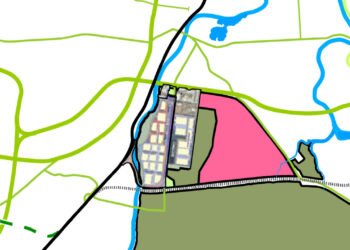Dual Moorebank Intermodals: A Raid on Local Residents
Under the patronage of Governor Lachlan Macquarie Liverpool was the first free settled town of NSW, and Australia, c1810. Thereafter the physical and financial inputs of Thomas Moore, and namesake of Moorebank, built the town, now city, which retains very little of it historical significance and outlook. For a great number of local residents it is apparent that this early investment has not been sustained or maintained. Two centuries later Liverpool is largely forgotten, taken for granted, or worse: existing as a dumping ground for bad ideas that serve vested private interests.
Long established residential areas of East Liverpool around the Holsworthy Military Reserve, such as Glenfield, Casula, Chipping Norton, Moorebank, Hammondville, Wattle Gove, Voyagers Point, most recently Georges Fair and the Liverpool CBD itself, have been beset by massive changes to their neighbourhoods as the controversial Moorebank Intermodal Terminals (MIMTs) have been pushed onto, and have taken shape on, the banks of the Georges River opposite the Casula Powerhouse Arts Centre (CPAC).
“You’re going to be seeing an awful lot of this bloody thing. And these buildings in the skyline… they’ve been allowed to expand in size significantly in height,” warned local radio host BJ during a recent interview with Eric North from Residents Against Intermodal Development (RAID) Moorebank Inc.
For locals, and all levels of government alike, the MIMTs aren’t just another industrial development – they represent the culmination of decades of political decisions that prioritised private and partisan vested interest over the public interest and environmental protections. The most immediate impact for residents will be the dramatic increase in heavy vehicle movements along already congested roads. With Port Botany handling 2.54 million 20ft shipping containers annually (2025) – and Stevedore operators at Port Botany seeking to triple this number to 7-8 million 20ft shipping containers annually – the port will be choked.
Rather than develop a superior and holistic eastern seaboard strategy to treat the problem at its source the problems of Port Botany will merely be duplicated, cut, then paste onto the Georges River at Moorebank. Where (c2013) the traffic and congestion on the M5 x Hume Highway is in fact worse than General Holmes Drive and Foreshore Road at Port Botany. Whether here or there, “all they care about is port side operations. Land side congestion? Pfft, that’s someone else’s problem – and so it’s our problem,” North explained during his interview on The Pulse radio show.
For residents of the surrounding suburbs of East Liverpool and beyond, this means, at minimum 13,000+ thousand more trucks everyday forcing their way onto the already oversaturated M5 x Hume Highway, in combination with 18,000+ thousand more cars everyday, creating noise and air pollution from dangerous levels of light and heavy vehicle congestion that will inevitably infect all the local and regional roads of East Liverpool.
A Problem That Could Have Been Avoided
What’s particularly galling for locals is that much of this congestion could have been avoided with better planning decades ago.
“There was only one rail line in and only one rail line out, from Port Botany” North revealed, “when duplication was proposed, and it’s taken 20 years for government to get on board with actually fixing that. Had they just done that one thing back in 2005, we would have met all of our original principal targets back by 2010.” In 2003 the NSW Govt set a target of 40% rail freight mode share by 2011. The share of railed containers was 20% at that time.
Moreover, instead of an integrated three-port-strategy, successive governments have pursued a centralised freight strategy focused solely on Port Botany, with Moorebank serving as a key distribution hub – despite community opposition and an objective view of the facts on the ground. North emphasised that RAID isn’t opposed to intermodal terminals or rail freight.
“We’re not opposed to intermodals per se, we’re not opposed; in fact we are in favour of rail freight for all of the reasons that the government will present; which is, yes, it is better for the environment, but it does matter – it matters where you spit the containers back out. That’s the key,” North said.
RAID has long advocated for what they call a “three port solution” that would distribute container freight across Newcastle, Sydney and Wollongong in line with serving their respective markets. This being promoted in place of forcing near all containers through Port Botany, through Sydneys congested road network.
The Privatisation Problem
The current predicament of going all in on Port Botany and assuming Moorebank will be its rescue, can in part be traced back to the privatisation of Sydney’s ports under former Premier Mike Baird1.
“Everything that was Sydney Port Corporation was now going to be privatised. That was Port Botany, Cooks River, Enfield and Port Kembla all sewn up in one deal,” North explained. This privatisation involved removing a crucial environmental cap of 3.2 million TEU (twenty-foot equivalent units) that had been established through proper legal processes. In essence “the bankers said, ‘if you remove that cap it’ll be worth billions more,'” North revealed. “The government actually had to change legislation and introduce legislation to get around the cap.”
The result is a system where “98% of all containerised freight has to go through Port Botany,” creating what North describes as a virtual monopoly.
“It’s like charging people for air, basically,” he said.
Newcastle: The Missed Opportunity
Perhaps the most frustrating aspect for those fighting against the dual MIMTs at Moorebank is that viable Portside alternatives exists – the Port of Newcastle. But, the privatisation deal included what North describes as “an illegal deal”2 that effectively prevents Newcastle from additional development as a container port, by imposing financial penalties.
“For every container over 10,000, which is minuscule, the company in Newcastle would effectively have to pay a fee,” North explained. “That fee, though it looked like it might be going to the government, was ultimately going to the private enterprise that now owned all the other ports.”
This arrangement has sparked ongoing legal battles as a result of development being effectively killed off for the Mayfield site in Newcastle, which North describes as “the biggest undeveloped port side piece of land we have.”3 For Liverpool residents, this means containers that could have been processed in Newcastle and Wollongong and railed to service their markets in Northern NSW and the Riverina respectively, will instead be forced through Port Botany and likely end up at Moorebank only to be thrown on a truck and driven to the next vendor or final destination.
Expensive double handling.
Political Origins
In the early 2000s the Howard Government was developing the Auslink program4. At no point was a terminal at Moorebank included in the policy Green Paper or policy White Paper any yet it is announced as federal government policy by Deputy Prime Minister John Anderson in 2004.5 As such a terminal at Moorebank appears to have political origins rather than being the result of proper planning processes.
“Our sense is that through Mr. Baird Senior, Bruce Baird, the then member of Cook and friend of [Patrick Stevedores chairman Chris] Corrigan… that was how it was facilitated, being pushed onto the list,” North said. “It’s turned into government policy and thereafter, do not question the emperor, so to speak.”
What’s Next for Residents?
As construction of the MIMTs continues, local residents are left wondering what their neighbourhoods will look like in five or ten years’ time. As well as what their neighbourhoods could have looked like if Liverpool itself and appropriately integrated master planning had been a priority.
Will the projections of massive container growth materialise, bringing thousands more trucks to local roads? Or will actual growth continue to lag behind the inflated projections that North describes as reflecting “the cargo cult”? “It’s all supply side economics…they create overcapacity, so they’ve got to find customers for all this obsolescent nonsense,'” North explained. Customers and consumers who should thus gratefully praise these rentier capitalist gatekeepers as though they bestow gifts from the gods6.
Either way, the decisions made decades ago, about Sydney’s port strategy – decisions driven by what North describes as “money, politics and ego” – will continue to shape daily life in Liverpool, Moorebank and surrounding suburbs for generations to come.
For now, residents can must watch as the massive warehouses and rail mounted gantries rise on their horizon. But as we unpack this multi-billon-dollar boondoggle new strategies and advocacy may emerge so that you can each find a way to contribute and fight back.
Join us Thursdays at 11am as we take a closer look at the Mooorebank Intermodal and investigate how this will effect local residents.
Listen to the full interview below.
- See details and links to other sources via this submission to TfNSW ↩︎
- See the Sydney Morning Herald, the Australian Financial Review and the Newcastle Herald ↩︎
- See the Port of Newcastle website and masterplan map; also see the ‘Publications’ section for economic and environmental data ↩︎
- For baseline references see Wikipedia, Australian Parliament House, and the (ANAO) Australian National Audit Office ↩︎
- See Sydney Morning Herald ↩︎
- See background on this concept and its application in Anthropology and WWII experiences ↩︎























